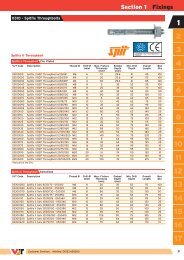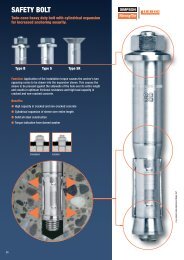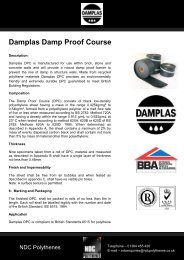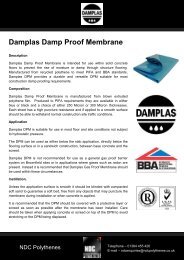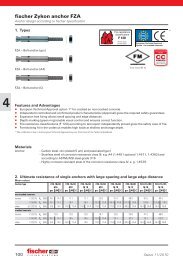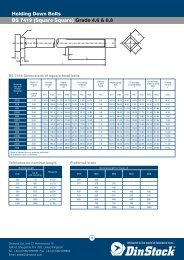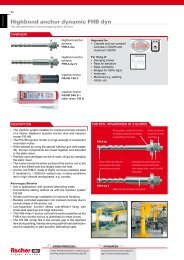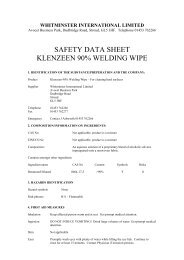Safety Data Sheet MSDS ID FID-100018 (EU)
Safety Data Sheet MSDS ID: FID-100018 (EU) - VJ Technology
Safety Data Sheet MSDS ID: FID-100018 (EU) - VJ Technology
You also want an ePaper? Increase the reach of your titles
YUMPU automatically turns print PDFs into web optimized ePapers that Google loves.
<strong>Safety</strong> <strong>Data</strong> <strong>Sheet</strong><br />
<strong>MSDS</strong> <strong>ID</strong>: F<strong>ID</strong>-<strong>100018</strong> (<strong>EU</strong>)<br />
1. Identification of the substance/preparation and of the company/undertaking<br />
Product details<br />
· Trade name: Rawl Fuel Cell for GPAT<br />
· Application of the preparation: Fuel Cell used in for installation of nails and brads by GPAT<br />
· Manufacturer/Supplier: Rawlplug Ltd Skibo drive<br />
Thornliebank Industrial Estate<br />
Glasgow G46 8JR<br />
Tel: +44 (0)141 638 7961; Fax: +44 (0)141 638 7397<br />
· Further information obtainable Technical Advisory Service, tel: +44 844 800 3320;<br />
from:<br />
fax: +44 (0) 844 300 3340; email: rawltech@rawlplug.co.uk<br />
· Information in case of<br />
emergency:<br />
0870 600 6266 – UK National Poisons Emergency Service<br />
2. Composition & information on Ingredients<br />
This product is a preparation. Component information below<br />
(Information for R phrases found in section 15)<br />
Component CAS# EINECS#<br />
Percentage<br />
w/w<br />
<strong>EU</strong><br />
classification<br />
Propane 74-98-6<br />
200-827-<br />
9 60-80 F+; R12<br />
N-Butane<br />
106-97-<br />
8<br />
203-448-<br />
7 15-25 F+; R12<br />
Isobutane 75-28-5<br />
200-857-<br />
2 20-40 F+; R12<br />
3. Hazard Identification<br />
Hazard classification (the classification is according to the <strong>EU</strong> Directive 1999/45/EC, and<br />
extended by company/literature data):<br />
F+; R12<br />
Physical/Chemical hazards: Extremely flammable. Product can cause flash fire.<br />
Compressed gas or refrigerated liquid. Contents are under pressure.
Human Health hazards:<br />
Eyes<br />
Contact with the liquefied or pressurised gas may cause momentary freezing followed by<br />
swelling and eye damage<br />
Skin<br />
Contact with the liquefied or pressurised gas may cause frostbite (‘cold’ burn). This material<br />
is a gas under normal atmospheric conditions No harmful effects from skin absorption are<br />
expected.<br />
Ingestion<br />
This material is a gas under normal atmospheric conditions and ingestion is unlikely.<br />
Inhalant<br />
Asphyxiant. High concentrations in confined spaces may limit oxygen available for breathing.<br />
Environmental Hazards<br />
Product is unlikely to cause ground or water pollution. Petroleum gases released into the<br />
environment will rapidly disperse into atmosphere and undergo photochemical degradation.<br />
4. First Aid measures<br />
Eyes<br />
When in contact with liquefied gas, hold eyelids apart and gently flush the affected eye(s)<br />
with lukewarm water. Seek immediate medical attention.<br />
Skin<br />
Treat burned or frostbitten skin by flushing or immersing the affected area(s) in lukewarm<br />
water. After sensation has returned to the frostbitten skin, keep skin warm, dry and clean. If<br />
blistering occurs, apply a sterile dressing. Seek immediate medical attention.<br />
Inhalation<br />
If respiratory systems develop, move the victim away from source of exposure and into fresh<br />
air. If symptoms persist, seek medical attention. If victim is not breathing, clear airway and<br />
immediately begin artificial respiration. If breathing difficulties develop, oxygen should be<br />
administered by qualified personnel. Seek immediate medical attention.<br />
Ingestion<br />
This material is a gas under normal atmospheric conditions and ingestion is unlikely.<br />
5. Fire fighting measures<br />
Flash Point - 60 0 C / - 140 0 C Method used: closed cup<br />
Upper flammable limit<br />
Lower flammable limit<br />
(UFL) 9.5<br />
(LFL) 1.8
General Fire Hazards<br />
This material is flammable and can be ignited by heat, sparks, flames, or other sources of<br />
ignition (e.g. static electricity, pilot lights, or mechanical/electrical equipment, and electronic<br />
devices such as cell phones, computers calculators, and pagers which have not been certified<br />
as intrinsically safe). Vapours may travel considerable distances to a source of ignition where<br />
they can ignite, flash back, or explode. May create vapour/air explosion hazard indoors in<br />
confined spaces, outdoors, or in sewers. If container is not properly cooled, it can rupture in<br />
the heat of a fire. Closed containers exposed to extreme heat can rupture due to pressure<br />
build up.<br />
Hazardous Combustion products<br />
Carbon dioxide and Carbon monoxide<br />
Extinguishing Media<br />
Dry chemical or carbon dioxide is recommended. Carbon dioxide can displace oxygen. Use<br />
caution when applying carbon dioxide in confined spaces.<br />
Fire fighting equipment/instructions<br />
For fires beyond the incipient stage, emergency responders in the immediate hazard area<br />
should wear bunker gear. When the potential chemical hazard is unknown, in enclosed or<br />
confined spaces, a self contained breathing apparatus should be worn. In addition, wear<br />
other appropriate protective equipment as conditions warrant (see section 8).<br />
Isolate immediate hazard area, keep unauthorised personnel out. Move undamaged<br />
containers from the immediate hazard area if it can be done with minimal risk. If this cannot<br />
be done, allow fire to burn. Cool equipment exposed to fire with water, if it can be done with<br />
minimal risk.<br />
Water spray may be useful in minimising or dispersing vapours and to protect personnel. Cool<br />
equipment exposed to fire with water, if it can be done with minimal risk.<br />
Water spray may be useful in minimising or dispersing vapours and to protect personnel. Cool<br />
equipment exposed to fire with water, if it can be done with minimal risk.<br />
6. Accidental release measures<br />
Containment Procedures<br />
Keep all sources of ignition and hot metal surfaces away from spill/release. The use of<br />
explosion-proof electrical equipment is recommended.<br />
Clean up Procedures<br />
Personnel must stay upwind and away from spill/release. Notify persons down wind of the<br />
spill/release, isolate danger area and keep unauthorised personnel out. Stop spill/release if it<br />
can be done with minimal risk. Wear appropriate protective equipment including respiratory<br />
protection as conditions warrant.<br />
Water spray may be useful in minimising or dispersing vapours.<br />
Evacuation Procedures<br />
In case of large spills, follow all facility emergency response procedures.
7. Handling and Storage<br />
Handling Procedures<br />
Avoid breathing vapours or spray mists. Avoid contact with skin and eyes.<br />
Contents are under pressure. The use of explosion-proof electrical equipment is<br />
recommended and may be required.<br />
The use of appropriate respiratory protection is advised when concentrations exceed any<br />
established exposure limits.<br />
Storage Procedures<br />
Pressurised container: must not be exposed for temperatures above 50 degrees C. Ground all<br />
equipment containing material.<br />
8. Exposure controls/Personal Protection<br />
Component occupational exposure limits<br />
Propane (74-98-6)<br />
ACGIH:<br />
German DFG:<br />
OEL (Switzerland):<br />
N-butane (106-97-8)<br />
ACGIH:<br />
German DFG:<br />
OEL (Switzerland):<br />
Isobutane (75-28-5)<br />
ACGIH:<br />
German DFG:<br />
OEL (Switzerland):<br />
1000ppm TWA (listed under Aliphatic hydrocarbon gases alkane C1-C4)<br />
1000ppm MAK; 1800mg/m3 MAK<br />
2000ppm Peak; 3600mg/m3 Peak<br />
4000ppm STEL; 7200mg/m3 STEL; 1000ppm MAK; 1800 mg/m3 MAK<br />
1000ppm TWA (listed under Aliphatic hydrocarbon gases alkane C1-C4)<br />
1000ppm MAK; 2400mg/m3 MAK (listed under Butane)<br />
4000ppm Peak; 9600mg/m3 Peak (listed under Butane)<br />
800ppm VLA-ED; 1900mg/m3 MAK<br />
1000ppm TWA (listed under Aliphatic hydrocarbon gases alkane C1-C4)<br />
1000ppm MAK; 2400mg/m3 MAK (listed under Butane)<br />
4000ppm Peak; 9600mg/m3 Peak (listed under Butane)<br />
800ppm VLA-ED; 1900mg/m3 MAK<br />
Engineering Controls<br />
If current ventilation practices are not adequate to maintain airborne concentrations below<br />
the established exposure limits, additional engineering controls may be required. Where<br />
explosive mixtures may be present, electrical systems safe for such locations must be used.<br />
Personal Protective Equipment (PPE)<br />
Eyes/face: Chemical goggles<br />
Skin: Rubber gloves are recommended.<br />
Respiratory: In case of brief exposure or low pollution, use respiratory filter device.<br />
In case of intensive or longer exposure, use self-contained respiratory protective device.<br />
Other protection: Appropriate clothing to prevent any possibility of liquid contact and<br />
repeated or prolonged vapour contact.
General: Do not smoke in work area. Wash at the end of each work shift and before eating,<br />
smoking and using the toilet. Promptly, remove any clothing that becomes contaminated.<br />
When using do not eat, drink or smoke.<br />
9. Physical & Chemical properties<br />
Physical state: Compressed gas Colour: Colourless<br />
Odour: Slight petrol smell pH: NA<br />
Vapour density ND Vapour pressure ND<br />
Boiling point: -11.7 0 C /'-42.1 0 C Melting point<br />
-160 0 C /'-<br />
187.1 0 C<br />
Solubility (H20): Negligible<br />
Specific Gravity (H 2 O =<br />
1): 1.56/2.01<br />
10. Chemical stability & Reactivity information<br />
Chemical stability<br />
Product is stable under normal ambient and anticipated storage and handling conditions of<br />
temperature and pressure. Product is flammable gas.<br />
Conditions to avoid<br />
Avoid all possible sources of ignition. Avoid contact with strong oxidising agents.<br />
Hazardous decomposition<br />
Carbon Monoxide, Carbon Dioxide.<br />
Hazardous Polymerisation<br />
Will not occur.<br />
11. Toxicological information<br />
Acute and Chronic toxicity<br />
Component analysis –LD50/LC50<br />
N-butuane (106-97-8)<br />
Inhalation LC50 Rat:<br />
Isobutane (75-28-5)<br />
Inhalation LC50 Rat:<br />
658000 mg/L/4H<br />
658000 mg/L/4H<br />
Sensitisation: No data available for this product<br />
Mutagenicity: No data available for this product<br />
Teratogenicity: No data available for this product<br />
Carcinogenicity: Component Carcinogenicity<br />
Isobutane (75-28-5)<br />
United Kingdom:<br />
R45 (may cause cancer); (containing at least 0.1% butadiene)
12. Ecological information<br />
Component analysis – Ecotoxicity – Aquatic Toxicity<br />
There is no information available on the ecotoxicological effects of petroleum gases. Due to<br />
their high volatility, they are unlikely to cause ground water pollution. Petroluem gases<br />
released into the environment will rapidly disperse into the atmosphere and undergo<br />
photochemical degradation.<br />
Environmental Fate<br />
No information available for the product<br />
Other adverse effects<br />
No information available for the product<br />
13. Disposal considerations<br />
Waste disposal instructions<br />
Do not crush, puncture or incinerate spent containers. Large numbers or aerosol containers<br />
may require handling as hazardous waste. Consult local government agencies for the proper<br />
disposal method in your area.<br />
14. Transportation information<br />
The description shown below may not apply to all shipping situations. Consult appropriate<br />
Dangerous Goods Regulations for additional description requirements and mode-specific or<br />
quantity specific shipping requirements.<br />
International Transportation Regulations:<br />
R<strong>ID</strong>/ADR (cross-border):<br />
Class: 2.1<br />
UN Number: 1950<br />
Label: Flammable gas<br />
Packaging group: _ _<br />
Proper shipping name: Aerosols, flammable<br />
IMO/IMDG:<br />
Class: 2.1<br />
UN Number: 1950<br />
Label: Flammable gas<br />
Packaging group: _ _<br />
Proper shipping name: Aerosols, flammable<br />
DOT:<br />
Class: 2.1<br />
UN Number: 1950<br />
Label: Flammable gas<br />
Packaging group: _ _<br />
Proper shipping name: Aerosols, flammable<br />
TDG:<br />
Class: 2.1<br />
UN Number: 1950<br />
Label: Flammable gas<br />
Packaging group: _ _<br />
Proper shipping name: Aerosols, flammable
15. Regulatory information<br />
Product classification and labelling (EEC)<br />
The following product has labelling requirements under Council Directive 67/548/EEC, Annex<br />
1.<br />
Classification:<br />
Label information:<br />
R12 Extremely flammable<br />
S9 Keep the container in a well-ventilated place.<br />
S16 Keep away from sources of ignition – No smoking.<br />
Contains: PROPANE (EC 200-827-9), ISOBUTANE (EC 200-857-2)<br />
Additional international regulatory information<br />
Component analysis – inventory<br />
Component CAS# TSCA DSL EINECS<br />
Propane 74-98-6 Yes Yes Yes<br />
N-butane 106-97-8 Yes Yes Yes<br />
Isobutane 75-28-5 Yes Yes Yes<br />
16. Other information<br />
Disclaimer:<br />
Supplier gives no warranty of merchantability or of fitness for a particular purpose. Any<br />
product purchased is sold on the assumption the purchaser will make his own tests to<br />
determine the quality and suitability of the product. Supplier expressly disclaims any and all<br />
liability for incidental and/or consequential property damage arising out of use of the product.<br />
No information provided shall be deemed to be a recommendation to use any product in<br />
conflict with any existing patent rights. Read the Material <strong>Safety</strong> <strong>Data</strong> <strong>Sheet</strong> before handling<br />
product.<br />
Key/Legend:<br />
NA: Not available or not applicable. ND: Not determined or No data. MAC: Maximum<br />
Allowable Concentration. TWA: Time Weighted Average. ACGIH: American Conference of<br />
Governmental Industrial Hygienists. IARC: International Agency for Research on Cancer.<br />
TSCA: Toxic Substance Control Act. DSL: Domestic Substances List (Canada). EINECS:<br />
European Inventory of Existing Commercial Substances.<br />
Sources Used:<br />
<strong>EU</strong> Directive 2001/58/EC<br />
<strong>EU</strong> Directive 1999/45/EC<br />
<strong>EU</strong> Directive 67/548/EEC<br />
Contact: Rawlplug Ltd<br />
Contact Telephone Number: 44 (0) 844 800 3320



